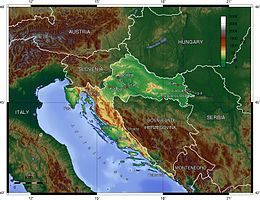
Back جغرافيا كرواتيا Arabic Xeografía de Croacia AST Геаграфія Харватыі Byelorussian Геаграфія Харватыі BE-X-OLD География на Хърватия Bulgarian ক্রোয়েশিয়ার ভূগোল Bengali/Bangla Geografija Hrvatske BS Geografie Chorvatska Czech Geografía de Croacia Spanish جغرافیای کرواسی Persian
 | |
| Continent | Europe |
|---|---|
| Region | Southern Europe |
| Coordinates | 45°8′30″N 16°13′45″E / 45.14167°N 16.22917°E |
| Area | Ranked 127th |
| • Total | 56,594 km2 (21,851 sq mi) |
| • Land | 99% |
| • Water | 1% |
| Coastline | 5,835.1 km (3,625.8 mi) |
| Borders | 2,237 km (1,390 mi) |
| Highest point | Dinara 1,831 m (6,007 ft) |
| Lowest point | Adriatic Sea (sea level) |
| Longest river | Sava 562 km (349 mi) |
| Largest lake | Lake Vrana 30.7 km2 (11.9 sq mi) |
The geography of Croatia is defined by its location—it is described as located at the crossroads of Central Europe and Southeast Europe, a part of the Balkans and Southern Europe. Croatia's territory covers 56,594 km2 (21,851 sq mi), making it the 127th largest country in the world. Bordered by Slovenia in the northwest, Hungary in the northeast, Bosnia and Herzegovina and Serbia in the east, Montenegro in the southeast and the Adriatic Sea in the south, it lies mostly between latitudes 42° and 47° N and longitudes 13° and 20° E. Croatia's territorial waters encompass 18,981 square kilometres (7,329 sq mi) in a 12 nautical miles (22 km; 14 mi) wide zone, and its internal waters located within the baseline cover an additional 12,498 square kilometres (4,826 sq mi).
The Pannonian Plain and the Dinaric Alps, along with the Adriatic Basin, represent major geomorphological parts of Croatia. Lowlands make up the bulk of Croatia, with elevations of less than 200 metres (660 ft) above sea level recorded in 53.42% of the country. Most of the lowlands are found in the northern regions, especially in Slavonia, itself a part of the Pannonian Basin plain. The plains are interspersed with horst and graben structures, believed to have broken the Pliocene Pannonian Sea's surface as islands. The greatest concentration of ground at relatively high elevations is found in the Lika and Gorski Kotar areas in the Dinaric Alps, but high areas are found in all regions of Croatia to some extent. The Dinaric Alps contain the highest mountain in Croatia—1,831-metre (6,007 ft) Dinara—as well as all other mountains in Croatia higher than 1,500 metres (4,900 ft). Croatia's Adriatic Sea mainland coast is 1,777.3 kilometres (1,104.4 mi) long, while its 1,246 islands and islets encompass a further 4,058 kilometres (2,522 mi) of coastline—the most indented coastline in the Mediterranean. Karst topography makes up about half of Croatia and is especially prominent in the Dinaric Alps, as well as throughout the coastal areas and the islands.
62% of Croatia's territory is encompassed by the Adriatic Sea. The area includes the largest rivers flowing in the country: the Danube, Sava, Drava, Mur and Kupa. The remainder belongs to the Adriatic Sea drainage basin, where the largest river by far is the Neretva. Most of Croatia has a moderately warm and rainy continental climate as defined by the Köppen climate classification. The mean monthly temperature ranges between −3 °C (27 °F) and 18 °C (64 °F). Croatia has a number of ecoregions because of its climate and geomorphology, and the country is consequently among the most biodiverse in Europe. There are four types of biogeographical regions in Croatia: Mediterranean along the coast and in its immediate hinterland; Alpine in the elevated Lika and Gorski Kotar; Pannonian along the Drava and Danube; and Continental in the remaining areas. There are 444 protected natural areas in Croatia, encompassing 8.5% of the country; there are about 37,000 known species in Croatia, and the total number of species is estimated to be between 50,000 and 100,000.
The permanent population of Croatia by the 2011 census reached 4.29 million. The population density was 75.8 inhabitants per square kilometre, and the overall life expectancy in Croatia at birth was 75.7 years. The country is inhabited mostly by Croats (89.6%), while minorities include Serbs (4.5%), and 21 other ethnicities (less than 1% each) recognised by the constitution. Since the counties were re-established in 1992, Croatia is divided into 20 counties and the capital city of Zagreb. The counties subdivide into 127 cities and 429 municipalities. The average urbanisation rate in Croatia stands at 56%, with a growing urban population and shrinking rural population. The largest city and the nation's capital is Zagreb, with an urban population of 797,952 in the city itself and a metropolitan area population of 978,161. The populations of Split and Rijeka exceed 100,000, and five more cities in Croatia have populations over 50,000.
© MMXXIII Rich X Search. We shall prevail. All rights reserved. Rich X Search